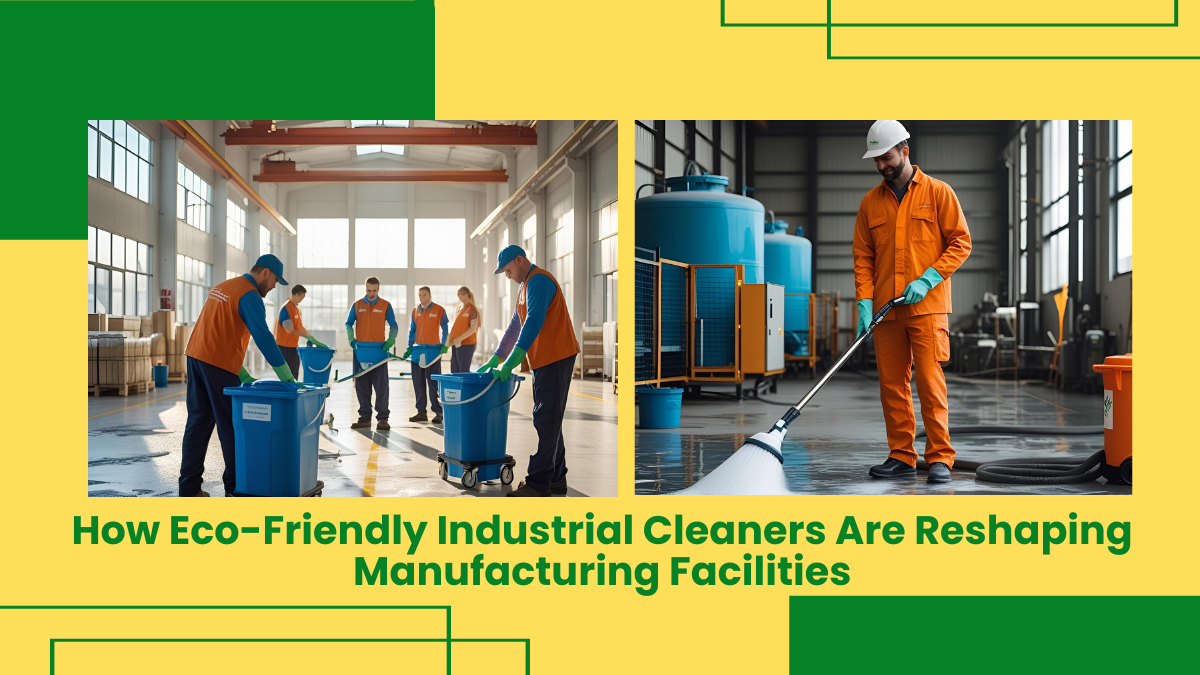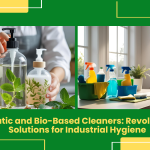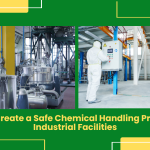Manufacturing plants worldwide are embracing eco-friendly industrial cleaners to address safety, environmental, and efficiency challenges. Traditional solvents and aggressive chemicals can harm workers, corrode equipment, and damage downstream processes, while stricter regulations and customer expectations increasingly demand greener operations. By switching to eco-friendly industrial cleaners bio-based, low-toxicity formulations, companies reduce risk, lower waste disposal costs, and demonstrate responsible stewardship. When paired with Ecochem’s digital signage platform, which connects securely to over 100 applications, every critical cleaning update and performance metric can be displayed anywhere on the shop floor in real time, reinforcing best practices and driving continuous improvement.
This comprehensive guide examines the problems faced with conventional cleaning methods, offers solutions enabled by eco-friendly industrial cleaners, and shares prevention tips for maintaining safe, compliant, and efficient operations. Along the way, you’ll find practical ways to leverage Ecochem’s integrations—such as linking laboratory test results, maintenance schedules, and waste-tracking systems—to broadcast vital data on screens throughout your facility.
Problems
1. Worker Health and Safety Risks
Traditional industrial solvents and acidic or caustic cleaners often emit volatile organic compounds (VOCs) and corrosive fumes. Prolonged exposure can lead to respiratory irritation, headaches, skin burns, and chronic conditions such as asthma. Facilities using outdated detergents also see elevated incident rates for chemical burns and eye injuries.
2. Equipment Corrosion and Downtime
Harsh chemicals can erode metal surfaces, degrade seals and gaskets, and compromise paint or protective coatings. Frequent repairs and part replacements increase maintenance budgets and cause unplanned downtime, reducing overall equipment effectiveness (OEE). In some cases, residue from aggressive cleansers can damage sensors or interfere with downstream processes, leading to rejects or product recalls.
3. Regulatory Pressure and Disposal Costs
Environmental protection agencies worldwide impose strict limits on hazardous waste generation, air emissions, and wastewater discharge. Non-compliance can trigger heavy fines, permit suspensions, and reputational harm. Traditional cleaners generate significant hazardous waste, requiring specialized disposal methods at high cost, on average 20–30% more per drum compared to non-hazardous alternatives.
4. Environmental Impact and Brand Reputation
Consumers and business partners increasingly scrutinize supply-chain sustainability. Facilities that rely on petrochemical-based cleaners contribute to ozone depletion, water pollution, and greenhouse gas emissions. Negative publicity around spills or improper disposal can damage brand credibility and lead to lost contracts.
5. Inconsistent Cleaning Performance
Aggressive chemicals often require long contact times and high concentrations to remove oils, greases, and particulate buildup. Inconsistent mixing ratios and temperature controls result in variable outcomes—sometimes over-cleaning, which wastes resources, and sometimes under-cleaning, which jeopardizes product quality and safety compliance.
Solutions
1. Adopt Bio-Based and Plant-Derived Formulations
Action: Transition to eco-friendly industrial cleaners made from renewable feedstocks—such as citrus extracts, soy or corn derivatives, and other plant oils—that break down easily and leave minimal residue. These formulations often match or exceed the performance of solvent-based products when properly selected for the targeted soil type.
Ecochem Integration: Connect your lab’s test result database (e.g., LIMS) to Ecochem so that comparative cleaning efficacy data displays on digital boards. Teams can see which eco-friendly formula delivers the best greasy residue removal under specified cycle times.
2. Implement Enzyme-Enhanced Cleaners for Grease and Protein Soils
Action: Utilize enzymes, such as proteases, lipases, and amylases, that catalyze the breakdown of complex soils into soluble fragments. These eco-friendly industrial cleaners work effectively at lower temperatures and shorter dwell times, cutting energy costs and speeding turnaround.
Ecochem Integration: Integrate enzyme activity monitors or temperature sensors with Ecochem. Real-time readings confirm that wash cycles hit the optimal pH and temperature range for maximal enzymatic action, reducing rework and ensuring consistent cleanliness.
3. Leverage pH-Neutral Formulas to Protect Surfaces
Action: Choose neutral-pH industrial detergents, eco-friendly industrial cleaners that avoid the risks associated with strong acids or alkalis. Such products safeguard metal components, rubber seals, and painted surfaces while still delivering robust removal of oils, greases, and particulate contaminants.
Ecochem Integration: Tie your maintenance management system (CMMS) into Ecochem. When inspections identify seal wear or corrosion, Ecochem triggers on-screen reminders to switch to neutral-pH options and schedule equipment checks.
4. Employ Water-Based Degreasers and Solvent Alternatives
Action: Replace petroleum-based degreasers with water-based formulations enhanced by surfactants and co-solvents that dissolve oils and tars without VOC emissions. These cleaners reduce flammability hazards and lower fume hood requirements.
Ecochem Integration: Link fume-hood usage data and indoor air-quality sensor readings to Ecochem displays. Operators can track solvent-free cleaning processes and see immediate improvements in air quality metrics, justifying further adoption.
5. Optimize Dilution Control and Dispensing Systems
Action: Install automated dosing and dispense stations that mix concentrated eco-friendly industrial cleaners with water accurately. Proper dilution not only ensures consistent cleaning power but also prevents waste and chemical overuse.
Ecochem Integration: Interface your dosing pumps with Ecochem so that screens show current dispense ratios, chemical levels in supply tanks, and alerts when refills are needed, avoiding machine stoppages and manual checks.
6. Incorporate Closed-Loop Wash Systems for Reuse
Action: Utilize filtration, sedimentation, and ultrafiltration systems to recover and reuse cleaning baths. Closed-loop equipment can cut chemical consumption, eco-friendly industrial cleaners and wastewater discharge by up to 70%, dramatically reducing the environmental footprint.
Ecochem Integration: Connect wastewater flow meters and filtration cycle data to Ecochem dashboards. Plant managers see real-time usage, water recovery rates, and maintenance intervals, enabling proactive filter changes before performance drops.
7. Train Staff on Eco-Friendly Cleaning Practices
Action: Develop training modules focused on correct mixer settings, dwell times, personal protective equipment (PPE), and spill response when using greener chemistries. Emphasize the performance benefits and cost savings tied to proper procedures.
Ecochem Integration: Deploy bite-sized training videos and quiz interfaces on Ecochem screens in break rooms and near cleaning stations. Track completion rates and comprehension scores via integration with your learning management system (LMS).
Prevention Tips
1. Maintain Rigorous Inventory Control
- Tip: Keep detailed records of eco-friendly industrial cleaner stock levels, expiration dates, and batch numbers. Use first-in, first-out (FIFO) policies to prevent outdated solutions.
- Ecochem Reminder: Sync your inventory management system (e.g., SAP, Oracle) to Ecochem. Digital displays alert warehouse teams when stock dips below reorder points or when solutions approach expiry.
2. Calibrate Dispensing Equipment Regularly
- Tip: Schedule quarterly calibration of dilution control units and dosing pumps. Even small deviations in mix ratios can impact cleaning efficacy or cause soil redeposition.
- Ecochem Reminder: Display upcoming calibration deadlines and an equipment status dashboard. Technicians see which units require attention before orders of replacement parts are placed.
3. Verify Efficacy with Routine Swab Tests
- Tip: Perform ATP or microbiological swab tests on critical surfaces to confirm cleanliness levels. Use zone-based sampling plans to cover the most challenging areas.
- Ecochem Integration: Feed test results into Ecochem, showing pass/fail indicators on screens. Teams immediately know if a follow-up cleaning cycle is required.
4. Encourage Feedback and Continuous Improvement
- Tip: Institute a frontline feedback loop for operators to report any cleaning challenges—spots missed, residue buildup, or slip hazards. Review comments weekly to refine product selection or process parameters.
- Ecochem Feature: Host a “Cleanliness Feedback” portal via Ecochem touchscreen displays. Operators rate cleanliness on a simple scale; results aggregate into trend charts for quality teams.
5. Plan for Safe Disposal of Spent Baths
- Tip: Even eco-friendly industrial cleaners solutions can require specific disposal guidelines. Segregate spent baths and send for recycling or treatment, following local regulations.
- Ecochem Integration: Integrate your waste-management partner’s tracking software with Ecochem. Digital signage confirms pick-up schedules, disposal certificates, and volume summaries for audit trails.
6. Rotate Product Trials to Identify Optimal Formulations
- Tip: Establish test runs with different eco-friendly industrial cleaners brands or chemistries on non-critical lines. Compare cycle times, energy use, and soil removal to select the best fit.
- Ecochem Tracking: Use Ecochem to create side-by-side dashboards comparing trial metrics—cleaning time, temperature, concentration—and share results facility-wide.
7. Monitor Water and Energy Usage
- Tip: Lower clean-in-place (CIP) cycle temperatures when possible; eco-friendly industrial cleaners often perform effectively at 40–50 °C rather than 70 °C. Recover heat from wash water with heat exchangers.
- Ecochem Alerts: Tie water flow meters and energy meters to Ecochem displays. Teams see immediate savings when cycles run at reduced temperatures and can set targets for further cuts.
Degrease The Grease With Eco-Green Kleen
Toughest Industrial degreaser is the need of cleansing stubborn greases out of the surfaces. Ecochem has Eco-Green Kleen, which is an eco-friendly chemical product in Mumbai and offers degreasing within minutes. Most of the available tough cleansers contain harsh chemicals that cause enough pollution in the atmosphere and also may lead to an adverse effect on the users with its unique feature of being a water-based formulation.
Descale The Grease With Eco-Green Kleenly
With a mission to clean and green, we at Ecochem has designed Eco-Green Kleenly as a washroom and bathroom cleaner. With most of the bacterial infections found in the restrooms, Eco-Green Kleenly is an eco-friendly solution to kill and sanitize the toilets and bathrooms with an advanced aromatic formula. It is a biotic acid-based product relevant for cleaning and removing the toughest stains of oil, grease, and paints without leaving any residue.
Bringing It All Together
Switching to eco-friendly industrial cleaners yields multiple benefits: improved worker safety, extended equipment life, lower regulatory burdens, and a smaller environmental footprint. But to realize these gains fully, facilities must integrate cleaner selection with robust process controls, thorough training, and real-time communication. That’s where Ecochem’s digital signage platform plays a crucial role.
By securely connecting with over 100 applications—such as your laboratory information system, maintenance management software, dosing control units, and environmental monitors—Ecochem delivers up-to-the-minute data wherever it’s needed. Operators see when to switch from conventional to plant-derived formulas, maintenance teams receive instant alerts about calibration or filter changes, and leaders track sustainability metrics on large‐format screens in conference rooms.
FAQ’S
What are eco-friendly industrial cleaners?
Eco-friendly industrial cleaners use plant-derived, biodegradable ingredients that reduce toxicity, environmental impact, and equipment wear while maintaining effective grease, soil removal.
How do these eco-friendly industrial cleaners protect worker health?
They minimize harmful fumes, VOCs, and skin hazards, improving air quality, reducing respiratory irritation, and requiring less PPE for cleaning
Can eco-friendly industrial cleaners match traditional solvent performance?
Yes, enzyme-enhanced, surfactant-rich formulations often match or exceed traditional solvent performance, cleaning effectively at lower temperatures and reduced cycle times.
How do eco-friendly industrial cleaners reduce environmental impact?
They biodegrade quickly, lower hazardous waste volumes, decrease water treatment needs, cut greenhouse gas emissions, and conserve energy in cleaning.
How to implement eco-friendly industrial cleaners in facilities?
Begin pilot trials, train teams on dilution, use dosing systems, monitor cleaning efficacy metrics, and refine processes based on feedback.
Written By: Vinny Jain


